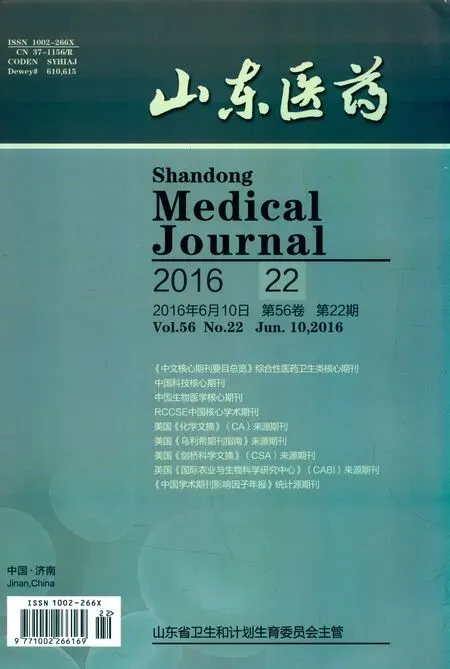不同浓度XAV939对肺腺癌细胞增殖和迁移能力的影响
李翀,郑旭,韩燕燕,吕艳,兰福,赵杰
(1天津中医药大学第一附属医院,天津300000;2天津中医药大学)
不同浓度XAV939对肺腺癌细胞增殖和迁移能力的影响
李翀1,2,郑旭1,韩燕燕1,吕艳1,兰福1,赵杰1
(1天津中医药大学第一附属医院,天津300000;2天津中医药大学)
目的观察不同浓度端锚聚合酶抑制剂XAV939对肺腺癌细胞增殖和迁移能力的影响。方法取肺腺癌A549细胞,分为XAV939组和空白对照组,XAV939组分别加入0.1、0.5、1.0、5.0、10.0 μmol/L的XAV939,空白对照组正常培养。采用MTT法观察各组细胞增殖情况,细胞划痕试验观察细胞24 h内的迁移能力,RT-PCR法检测细胞中WNT通路转录因子β-catenin mRNA表达,免疫荧光法对细胞β-catenin表达进行定位。结果①24、48 h时XAV939组不同浓度的细胞增殖抑制率均较空白对照组升高(P均<0.05);同一时间点XAV939组不同浓度的细胞增殖抑制率比较有统计学差异,随XAV939浓度增加,细胞增殖抑制率增加(P<0.05)。②24 h时,XAV939组不同浓度的细胞划痕宽度均大于空白对照组(P均<0.05)。③XAV939组不同浓度β-catenin mRNA表达均较空白对照组减少(P均<0.05)。④空白对照组及XAV939组0.1、1.0、10.0 μmol/L的β-catenin荧光染色逐渐由细胞核和细胞质转移至细胞质和细胞膜。结论XAV939可抑制肺腺癌A549细胞增殖和迁移,其作用机制可能与抑制WNT通路的异常激活相关。
XAV939;肺腺癌;细胞增殖;β-连环蛋白
端锚聚合酶(TNKS)是首个被发现的能与端粒酶重复绑定序列结合的蛋白,属于聚ADP核糖聚合酶蛋白家族。TNKS在肺腺癌中多呈高水平表达。在肺癌模型中敲除TNKS可以减少细胞增殖,抑制肿瘤细胞形成[1],因此TNKS抑制剂可能为肺癌的治疗提供新的途径。XAV939是TNKS小分子选择性抑制剂,可抑制WNT通路转录因子β-catenin调节的转录,而WNT信号通路对调控细胞增殖、分化、凋亡和迁移起重要作用,其异常表达和激活可诱发肿瘤[2,3]。研究证明,XAV939可降低β-catenin活性和上皮间充质转化程度[4]。XAV939与TNKS结合后,可刺激β-catenin磷酸化,抑制WNT信号途径的激活[5,6]。2015年4月,我们观察了不同浓度XAV939对人肺腺癌A549细胞增殖和迁移能力的影响,并探讨其与WNT信号通路的关系。
1 材料与方法
1.1材料人非小细胞肺癌A549细胞株由天津市人民医院馈赠。XAV939购自美国Selleck公司(S1180),胎牛血清、RPMI-1640培养基购自美国HyClone公司;四甲基偶氮唑盐(MTT)和二甲基亚砜(DMSO)均购自美国Sigma公司。
1.2方法
1.2.1细胞培养将A549细胞加入含10%胎牛血清的改良型RPMI-1640培养基中,置于37 ℃、5% CO2、饱和湿度的培养箱内,取对数生长期细胞进行实验。
1.2.2细胞增殖能力观察采用MTT法。取对数生长期细胞,按2×104/mL接种到96孔板。将细胞分为XAV939组和空白对照组,XAV939组分别加入0.1、0.5、1.0、5.0、10.0 μmol/L的XAV939,空白对照组正常培养。每组设6个复孔,置于37 ℃培养箱内培养24、48 h时,分别加入10 μL MTT孵育4 h,离心,弃上清,加入150 μL DMSO,摇匀。用酶标仪于490 nm波长处测定吸光度A值,计算细胞增殖抑制率。细胞增殖抑制率=(1-处理组A490值/空白对照组A490值)×100%。
1.2.3细胞迁移能力观察采用细胞划痕试验。取对数生长期细胞,按1×105/孔接种于12孔板。细胞分组同1.2.2。待细胞长满单层后,用100 μL枪头在中间划一横线,以PBS洗去划痕后漂浮的细胞,光学显微镜下观察并拍照。加入无血清培养液继续培养24 h,光学显微镜下再次观察并拍照。应用Image-Pro Plus6.0软件测量划痕宽度,以两次划痕宽度的差值作为检测结果,实验重复3次。
1.2.4β-catenin mRNA表达检测采用RT-PCR方法。取对数生长期细胞,分为XAV939组和空白对照组,XAV939组分别加入0.1、0.5、1.0、5.0、10.0 μmol/L的XAV939,空白对照组正常培养。培养24 h后,TRIzol法提取细胞RNA,行RNA定量后逆转录合成cDNA,并进行PCR反应。β-catenin引物序列上游:5′-ATCATTCTGGCCAGTGCTGG-3′,下游:5′-GACAGCACCTTCAGCACTCT-3′,产物长度为104 bp。以β-actin作为内参,引物序列上游:5′-TCTGTGTGGATTGGTGGCTCT-3′,下游:5′-AGAAGCATTTGCGGTGCAC-3′,产物长度为115 bp。PCR反应条件:95 ℃ 5 min,95 ℃ 30 s、60 ℃ 30 s、72 ℃ 30 s、40个循环;72 ℃ 5 min。凝胶成像用Image J软件进行分析。
1.2.5β-catenin定位采用免疫荧光法。取对数生长期细胞加入含无菌小圆片的24孔板,待爬片完成后分为对照组和0.1、1.0、10.0 μmol/L XAV939组,分别加入0.9%氯化钠和0.1、1.0、10.0 μmol/L XAV939。培养48 h后加入0.4%多聚甲醛固定,小心取出小圆片粘于载玻片上, 0.5% Triton-X100打孔,血清封闭。加入β-catenin单克隆一抗(Santa cruz,1∶100)4 ℃过夜,加入二抗FITC标记的山羊抗小鼠IgG(1∶100)避光孵育,DAPI复染细胞核,荧光显微镜下观察。β-catenin阳性表达呈绿色荧光。

2 结果
2.1不同浓度XAV939作用后细胞增殖抑制率比较见表1。

表1 不同浓度XAV939作用后细胞增殖抑制率比较
注:与同浓度24 h时比较,△P<0.05。
2.2各组细胞迁移能力比较24 h时,空白对照组和XAV939组0.1、0.5、1.0、5.0、10.0 μmol/L的划痕宽度差值分别为(106.4±10.5)、(165.8±12.3)、(176.6±11.9)、(267.4±13.5)、(328.7±18.1)、(445.4±21.6)μm,XAV939组不同浓度均大于空白对照组(P均<0.05)。除0.1与0.5 μmol/L组间比较差异无统计学意义外,其余各组间比较差异均有统计学意义(P均<0.05)。
2.3各组细胞β-catenin mRNA表达比较空白对照组和XAV939组10.0、1.0、0.1 μmol/L细胞β-catenin mRNA表达分别为0.58±0.024、0.27±0.035、0.47±0.033、0.44±0.016。与空白对照组比较,XAV939组不同浓度表达明显减少(P均<0.05)。除1、0.1 μmol/L间差异无统计学意义外,其余各浓度间比较差异均有统计学意义(P均<0.05)。
2.4β-catenin定位结果对照组β-catenin阳性呈绿色荧光,位于细胞核和细胞质中;随XAV939浓度增加,β-catenin阳性染色由细胞核和细胞质逐渐转移至细胞质和细胞膜。
3 讨论
肺癌的发病机制复杂,经典WNT/β-catenin信号通路在肺癌的发生发展中具有重要作用[7,8],抑制WNT通路可能成为肺癌药物的作用靶点。WNT信号系统中的许多生物学进程和致病过程都受到TNKS及其抑制剂的调控[9]。我们的前期研究发现,TNKS和β-catenin在肺腺癌中均呈高表达,且二者表达呈正相关,而β-catenin又是WNT通路的关键调控因子,由此推测TNKS高表达可能与WNT通路的异常激活相关。XAV939可抑制WNT通路转录因子β-catenin信号的转录,已用于多种癌症的治疗[10]。在乳腺癌MDA-MB-231细胞系中,XAV939能够减弱WNT3a诱导的细胞迁移[11];在神经母细胞瘤中,XAV939可以通过抑制WNT/β-catenin通路促进细胞凋亡[12]。
本研究显示,不同浓度XAV939对肺腺癌A549细胞作用24、48 h时,随XAV939浓度增加,A549细胞增殖抑制率递增;相同XAV939浓度作用不同时间的细胞增殖抑制率比较,除1 μmol/L组无显著变化外,其他各组均显著增加。表明随作用时间延长,XAV939对A549细胞的增殖抑制作用呈递增趋势。细胞划痕试验结果表明,XAV939可抑制A549细胞迁移,且随浓度增加,抑制作用逐渐增强。
β-catenin是WNT通路中重要的信号传递子,其在胞质内的稳定、蓄积及入核是该信号传递的重要步骤。在正常细胞中,β-catenin主要位于细胞膜,胞质中很少。而一旦在胞质发生累积,β-catenin转位入核增多,与转录因子TCF/LEF结合并激活转录因子,可促进下游靶基因的转录,对细胞增殖和分化进行调节,WNT通路的异常激活可导致肿瘤发生[13]。根据以上细胞增殖和划痕实验结果,以及划痕实验中0.1与0.5 μmol/L组间比较差异无统计学意义,选择0.1、1.0、10.0 μmol/L XAV939对β-catenin的表达进行荧光定位。本研究发现,0.1、1.0、10.0 μmol/L组较空白对照组β-catenin表达明显减少,10.0 μmol/L组较其他浓度组明显减少。免疫荧光定位结果显示,对照组、0.1、1.0、10.0 μmol/L组中β-catenin阳性表达逐渐由细胞核转移到细胞质和细胞膜。由此推测,XAV939可促进β-catenin降解,阻止其在细胞质中沉积,进而抑制其转位入核,最终抑制WNT通路的异常激活,可能是XAV939抑制肺腺癌A549细胞增殖和迁移的机制。
综上所述,TNKS抑制剂XAV939在肺腺癌A549细胞中可抑制其增殖和迁移,其作用机制可能与促进β-catenin降解,抑制WNT通路相关。XAV939可能成为治疗肺癌的新型潜在靶标。
[1] Busch AM, Johnson KC, Stan RV, et al. Evidence for tankyrases as antineoplastic targets in lung cancer[J]. BMC Cancer, 2013,13(1):122-129.
[2] Holland JD, Klaus A, Garratt AN, et al. Wnt signaling in stem and cancer stem cells[J]. Semin Cell Dev Biol, 2010,21(8):254-264.
[3] Anastas JN, Moon RT. WNT signalling pathways as therapeutic targets in cancer[J]. Nat Rev Cancer, 2013,13(1):11-26.
[4] Arnau U, Ying W, Kim KK, et al. Axin pathway activity regulates in vivo pY654-β-catenin accumulation and pulmonary fibrosis[J]. J Biol Chem, 2012,287(7):5164-5172.
[5] Wang C, Zhu H, Sun Z, et al. Inhibition of Wnt/β-catenin signaling promotes epithelial differentiation of mesenchymal stem cells and repairs bleomycin-induced lung injury[J]. Am J Physiol Cell Physiol, 2014,307(3):C234-244.
[6] Kamal A, Riyaz S, Srivastava AK, et al. Tankyrase inhibitors as therapeutic targets for cancer[J]. Curr Top Med Chem, 2014,14(17):1967-1976.
[7] Hans Clevers, Roel Nusse. Wnt/β-Catenin Signaling and Disease[J]. Cell, 2012,149(6):1192-1205.
[8] Lecarpentier Y, Claes V, Duthoit G, et al. Circadian rhythms, Wnt/beta-catenin pathway and PPAR alpha/gamma profiles in diseases with primary or secondary cardiac dysfunction[J]. Front Physiol, 2014,5(5):429.
[9] Arques O, Chicote I, Puig I, et al. Tankyrase inhibition blocks Wnt/β-catenin pathway and reverts resistance to PI3K and AKT inhibitors in the treatment of colorectal cancer[J]. Clin Cancer Res, 2016,22(3):644-656.
[10] Dregalla RC, Junqing Z, Idate RR, et al. Regulatory roles of tankyrase 1 at telomeres and in DNA repair: suppression of T-SCE and stabilization of DNA-PKcs[J].Aging,2010,2(10):691-708.
[11] Renyue B, Tania C, Siyuan S, et al. Inhibition of tankyrases induces Axin stabilization and blocks Wnt signalling in breast cancer cells[J]. PLoS One, 2012,7(11):3725-3744.
[12] Tian XH, Hou WJ, Yan F, et al. XAV939, a tankyrase 1 inhibitior, promotes cell apoptosis in neuroblastoma cell lines by inhibiting Wnt/β-catenin signaling pathway[J]. J Exp Clin Cancer Res, 2013,32(1):806-808.
[13] Zhang X, Lou Y, Zheng X, et al. Wnt blockers inhibit the proliferation of lung cancer stem cells[J]. Drug Des Devel Ther, 2015,9:2399-2407.
Effects of different concentrations of XAV939 on proliferation and migration of lung adenocarcinoma cells
LIChong1,ZHENGXu,HANYanyan,LYUYan,LANFu,ZHAOJie
(1FirstTeachingHospitalofTianjinUniversityofTraditionalChineseMedicine,Tianjin300000,China)
Objective To investigate the effects of different concentrations of tankyrase small molecule inhibitor XAV939 on proliferation and migration of lung adenocarcinoma cells.MethodsThe lung adenocarcinoma A549 cells were divided into 6 groups: five XAV939 groups which were treated with 0.1, 0.5, 1.0, 5.0 and 10.0 μmol/L XAV939 and blank control group. MTT method was used to detect the cell proliferation of each group and cell scratch test was used to detect the cell migration ability within 24 h. β-catenin mRNA expression was detected by RT-PCR. The expression of β-catenin was located by immune fluorescence. Results①At 24 h or 48 h, the A549 cell proliferation inhibition rates in different XAV939 groups were higher than that in the blank control group (allP<0.05). At the same time point, there was a significant difference in the inhibitory rate of cell proliferation among different concentration groups of XAV939. With the increase of XAV939 concentration, the inhibition rate of cell proliferation increased (P<0.05). ②At 24 h, the scratch width of different XAV939 groups was significantly greater than that of the blank control group (allP<0.05). ③The expression of β-catenin mRNA in different XAV939 groups was significantly decreased as compared with that of the blank control group (allP<0.05).④ In the blank control group, 0.1, 1.0 and 10.0 μmol/L XAV939 group, β-catenin gradually transferred from the expression of cytoplasm/membrane to the expression of nucleus/cytoplasm. ConclusionsXAV939 in vitro may inhibit the proliferation and migration abilities of lung adenocarcinoma A549 cells. The mechanism may be related to the inhibition of abnormal activation of WNT pathway.
XAV939; lung adenocarcinoma; cell proliferation; β-catenin
天津市卫生局科技基金项目(2014KZ130)。
李翀(1974-),女,硕士,副主任医师,主要研究方向为肿瘤病理学。E-mail: lc740922@163.com
10.3969/j.issn.1002-266X.2016.22.005
R734.2
A
1002-266X(2016)22-0015-03
2016-02-17)

